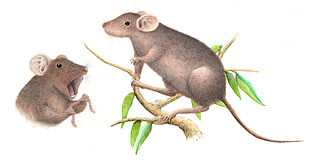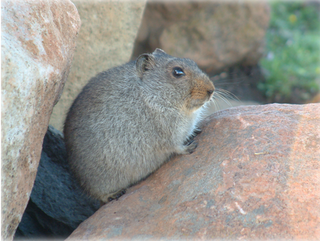
The Old World rats and mice, part of the subfamily Murinae in the family Muridae, comprise at least 519 species. Members of this subfamily are called murines. In terms of species richness, this subfamily is larger than all mammal families except the Cricetidae and Muridae, and is larger than all mammal orders except the bats and the remainder of the rodents.
Sommer's Sulawesi rat is a species of rodent in the family Muridae from Sulawesi. It is the only species in the genus Sommeromys and was described by Musser & Durden in 2002.

The large Mindoro forest mouse is a species of rodent in the family Muridae, from the genus Apomys. It is found only in the Philippines. Its natural habitat is subtropical or tropical moist montane forests. It is a large mouse with large feet, a long tail and an elongated snout which is morphologically unique within its genus. It is covered in soft fur which is mostly dark brown in colour. Its closest relative is thought to be the Luzon montane forest mouse, based on genetic and morphological similarities.
The West African shaggy rat is a species of rodent in the family Muridae. It is found in Benin, Cameroon, Ivory Coast, Gambia, Ghana, Guinea, Guinea-Bissau, Liberia, Mali, Nigeria, Senegal, Sierra Leone, and Togo. Its natural habitats are subtropical or tropical seasonally wet or flooded lowland grassland and swamps. It is a common species and the International Union for Conservation of Nature has rated its conservation status as being of "least concern".
The Mount Oku hylomyscus is a species of rodent in the family Muridae. Found only on Mount Oku, Cameroon, in tropical Central Africa, its natural habitat is tropical moist montane forests. It has a very small range and is threatened by habitat destruction, so the International Union for Conservation of Nature has rated its conservation status as being "critically endangered".
The gray tree rat is a species of rodent in the family Muridae. only species in the genus Lenothrix. It is found in forests in Indonesia and Malaysia. A common species, the IUCN has rated it as being of "least concern".
The Ethiopian forest brush-furred rat or golden-footed brush-furred rat, is a species of rodent in the family Muridae. It is endemic to Ethiopia where its natural habitat is subtropical or tropical moist montane forests. It is threatened by habitat loss.
Beccari's margareta rat is a species of rodent in the family Muridae. It is endemic to the island of Sulawesi in Indonesia.
Margaretamys is a genus of rodent in the family Muridae endemic to the island of Sulawesi in Indonesia. Up until 1973, it was known from only few examples of one species. Then Guy G. Musser collected more examples of this species during his stay in Sulawesi, as well as collecting two new species. And in 1981, as part of his huge project of sorting through the then very large genus Rattus, he described these as members of the new genus, Margaretamys.
The elegant margareta rat is a species of rodent in the family Muridae. It is endemic to the island of Sulawesi in Indonesia.
The little margareta rat is a species of rodent in the family Muridae. It is endemic to the island of Sulawesi in Indonesia.
Oligoryzomys magellanicus, also known as the Patagonian colilargo and the Magellanic pygmy rice rat, is a species of rodent in the genus Oligoryzomys of the family Cricetidae. It is found in the southernmost parts of Argentina and Chile, including Tierra del Fuego and other outlying islands. Its karyotype has 2n = 54 and FNa = 66.

Sloggett's vlei rat or ice rat is a species of rodent in the family Muridae. It is found in southern Lesotho and South Africa where its natural habitats are subtropical or tropical high-altitude grassland, swamps, and rocky areas. Its name commemorates Col. Arthur Sloggett who served in South Africa and collected at Deelfontein in 1902. This is a common species and the International Union for Conservation of Nature has rated it as being of "least concern".

The Malayan field rat, Malaysian field rat or Malaysian wood rat, is a species of rodent in the family Muridae. It is nocturnal and mainly arboreal and is found in Malaysia, Thailand, Indonesia and the Philippines. It is a common species and the International Union for Conservation of Nature has assessed it as being of "least concern".

The Salokko rat is a species of rodent in the family Muridae.
Guy Graham Musser was an American zoologist. His main research was in the field of the rodent subfamily Murinae, in which he has described many new species.
Leptomys paulus is a small rodent belonging to the family Muridae endemic to New Guinea.
Halmaheramys bokimekot, the spiny Boki Mekot rat, is a rodent found on the island of Halmahera in the Molucca archipelago, whose discovery was announced in 2013. This is the only locality where this particular species has been found. H. bokimekot was confirmed as a new species through probabilistic methodologies applied to morphological and molecular data.

Rattini is a very large, diverse tribe of muroid rodents in the subfamily Murinae. They are found throughout Asia and Australasia, with a few species ranging into Europe and northern Africa. The most well-known members of this group are the true rats, several species of which have been introduced worldwide.
The Karoko hill rat is a species of rodent in the family Muridae. It is found only in Sulawesi, Indonesia.





